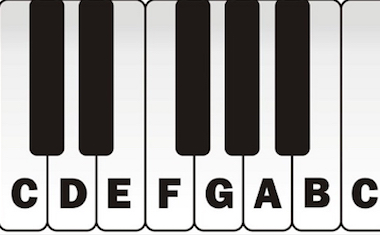Welcome back to my music theory series. This month we’re going to look at the natural major scale.
What is a scale exactly? In western music, a scale is any set of musical notes ordered by note/pitch. A scale increasing in note/pitch is an ascending scale, and a scale decreasing in note/pitch is a descending scale.
Let’s take a look at a C major scale below…

You’ll notice that the notes of this scale ascend as follows… C D E F G A B C and then descend B A G F E D C.
Let’s see what that would look like on the piano keyboard…

A natural major scale like C major has a series of whole steps and half steps. (W represents whole) and (H represents half). in this case it would be as follows… W W H W W W H. Let’s break that down… the distance between C to D is a whole step. D to E is a whole step. E to F is a half step. F to G is a whole step. G to A is a whole step. A to B is a whole step. B to C is a half step. Make sense?
Now within this C major scale each note is assigned a scale degree. Take a look below…

You’ll notice that each note contains a roman numeral 1 through 7 and then back to 1. Each numeral is assigned a name. Tonic, supertonic, mediant, subdominant, dominant, subdominant, leading tone, tonic. Now let’s break that down…
Tonic- is the root note of the scale.
Supertonic- is called this because it’s the note directly above the root note.
Mediant- coming from the Latin word meaning middle. It’s usually a middle note used in simple harmonies. (We’ll get to that topic at a later date).
Subdominant- sub meaning ‘below’ the dominant degree of the scale.
Dominant- This fifth degree of the scale and to our ears the dominant scale degree likes to resolve to the tonic.
Submediant- because it’s a third below the tonic.
Leading tone- meaning leading back to the tonic or root note.
We’ll get to the importance of these scale degrees when discussing harmony and chords. But for now just know that these are the names of the scale degrees as it relates to the natural major scale.
I just listed C Major above as an example. But you could literally go around the Circle of Fifths and do this for all the Major scales starting on the tonic/root and build the scale off the intervals of W W H W W W H.
Next month we’ll cover a different type of scale together. In the meantime, memorize your intervals for the natural major scale and the names of the scale degrees!



I love reading these. awesome stuff
Thanks for listening Moe!